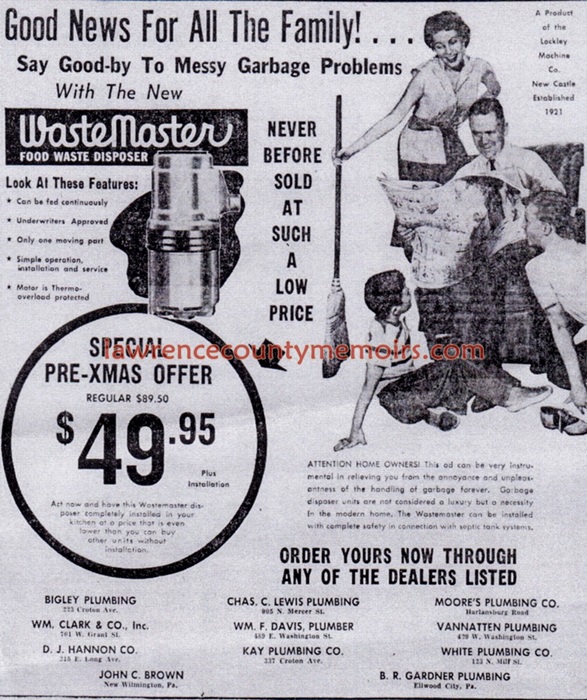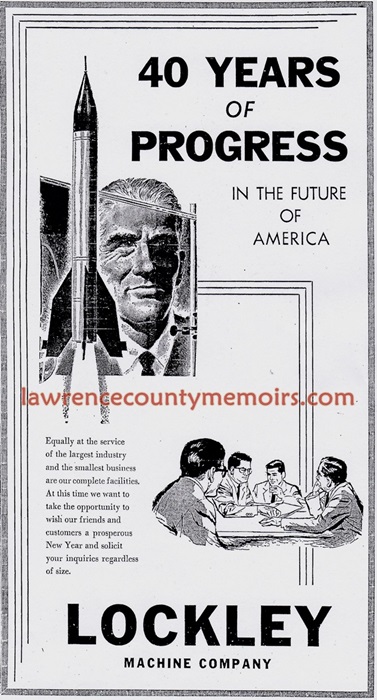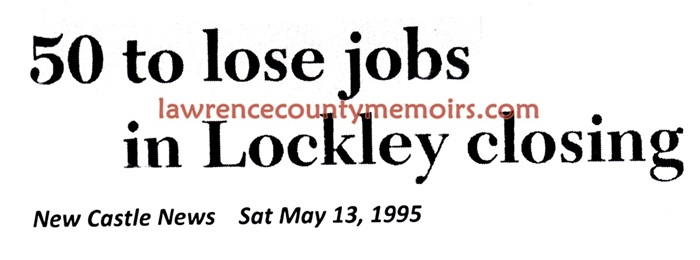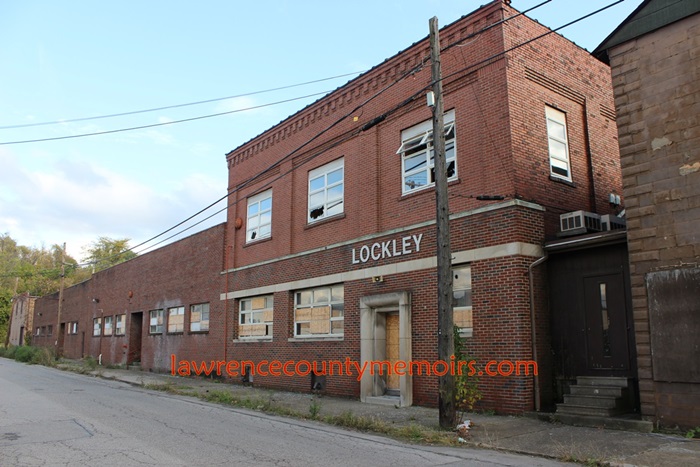Harry W. Lockley was born in Edinburg, Pennsylvania, in October 1882, the son of Herbert and Ella (Lamm) Lockley. In 1905 he was married to Mabel Cramer and their union eventually produced five children – Elroy C. Lockley in 1907, Sidney L. Lockley in 1908, Dorothy Lockley in 1910, Joseph E. Lockley in 1912, and Harry L. Lockley in 1914. The same year they were married they moved to New Castle and he found employment with the American Car and Ship Hardware Manufacturing Company. Lockley, a gifted engineer, rose through the ranks and soon became a foreman with the company – which became known as Johnson Bronze in 1916.
The family eventually took up residence at #727 Countyline Road on the eastern limits of New Castle. Harry Lockley left Johnson Bronze in 1921 and established his own machine shop business. The Lockley Machine Company was started in his basement and soon expanded into a backyard shop. An advertisement from 1927 indicates his business was “Equipped to handle all kinds of machine work up to 36 inches diameter.” In 1931 he experimented with producing a “Home Instant Dryer,” an early model clothes dryer, but the product was not well received at that time. Clothes dryers did not become a common home appliance until several decades later.
Lockley, a devoted Methodist, was a community leader and huge supporter of local educational efforts. He made sure his all four of his sons attended college and studied engineering. When he went into semi-retirement in 1937 he turned the daily operations of the business over to his sons.
All of the Lockley boys would become outstanding members of the local community. Sidney would serve two terms as City Controller, teach Sunday school classes for many years, and serve as the first ever chairman of the New Castle Redevelopment Agency. Joseph, in addition to working at the plant, became a longtime educator and would teach at several schools to include Walmo Elementary and George Washington Junior High. Harry would later coordinate engineering classes at the Lawrence County Vo-Tech High School when it opened in 1966. Elroy, who oversaw all personnel at the company, became a star athlete on various recreational sports teams sponsored by the firm.
During 1941, with America’s involvement in World War II looming on the horizon, the Lockley firm acquired a lucrative federal government contract to make armor-plated doors for tanks of the U.S. Army. Needing a larger facility Lockley acquired the former Bell Bakery building in New Castle in May 1942. They relocated into the Grove Street building and greatly expanded operations over the next few years. In July 1945 they were presented with the prestigious Army-Navy “E” Award for manufacturing excellence in support of the military effort. During the war founder Harry W. Lockley even came out of retirement to teach machine shop classes at the vocational school (or shop building) located at Ben Franklin Junior High School.
In October 1947 the company, looking to diversify, opened a new shop to manufacture garbage disposals for home use. Their “Wastemaster” garbage disposals, which were to be installed on kitchen sinks, became very popular in the coming years. Lockley Machine thrived and by the end of the decade it employed about 200 workers.
Harry W. Lockley, one of the county’s most outstanding citizens, passed away on October 27, 1948, at the age of sixty-six. He was laid to rest in Oak Park Cemetery. His outstanding commitment to local education was recognized by the New Castle School Board and in 1953 his name was selected to grace a proposed new elementary school. The Harry W. Lockley Elementary School, which replaced the aging Oak Street School, opened for classes in September 1955. Many years later this building was replaced with the modern Harry W. Lockley Early Learning Center when it opened in September 2014.
Soon after Harry Lockley’s death his four sons, as the new owners, officially incorporated as the Lockley Machine Company. They installed Sidney Lockley as President, Harry as Vice President of Operations, Elroy as Vice President of Personnel, and Joseph as the Secretary-Treasurer. Their sister Dorothy was married to Clifford R. Roberts, a machinist employed in the Lockley plant. Expansion continued into the 1950’s as Lockley acquired multiple defense contracts during the Korean War.
The plant was fortunate to survive a devastating fire on Monday, December 18, 1950. The Arena, a wooden roller skating rink and sports venue that sat next door on Grove Street, was engulfed in a raging inferno and reduced to rubble. Only a determined effort by local firefighters saved the Lockley facility. The firm soon acquired the Arena property and built two additional small shops in the next few years.
Another raging fire broke out in the rear of the Lockley Machine Company and destroyed the Citizens Lumber Company on Thursday, December 5, 1959. Once again firemen worked valiantly to save the Lockley plant from destruction. Two subsequent fires that started on the Lockley property did cause damage though. Those fires, on Thursday, July 13, 1961, and Sunday, October 20, 1963, caused $23,600 and $8,000 damage respectively to facilities and equipment.
Business boomed during the 1960’s, but Elroy C. Lockley, the eldest son of founder Harry W. Lockley, died after a brief illness in October 1961. He was only fifty-four years old and his death came as a shock to the family.
Back in 1958 the company had been awarded a contract to make practice bombs for the U.S. Air Force. A steelworkers’ strike in 1959 slowed progress, but in early 1960 the company was back in full gear. The growing conflict in Vietnam fueled a need for numerous war materials and Lockley benefited immensely. During the coming decade they acquired a handful of additional lucrative contracts in connection with the Air Force, made rocket motors, missile casings, and anti-mine explosive kits for the U.S. Army, and manufactured aircraft carrier catapult parts, missile components, and torpedo containers for the U.S. Navy.
Lockley Machine, needing additional work and storage space, leased the former site of the American Can Company (which closed in 1950) on Industrial Street in Mahoningtown beginning in 1961. They purchased this property outright in late 1966. Several employee strikes halted business at times during the decade, but they all ended with contract agreements.
In early November 1969 the company underwent a reorganization effort and Sidney Lockley stepped down as President. He would remain active as an advisor and Chairman of the Board until he fully retired in 1975. Norman N. Smilek, Sidney Lockley’s son-in-law and chief engineer, was installed as the new President. Sidney’s brother Harry had since retired, and only his brother Joseph remained active as the Secretary.
The company looked to diversify as the 1970’s and the end of the conflict in Vietnam approached. Back in 1968 they had opened a recreational division, which manufactured light sailboats and other outdoor equipment. Within a few years the company was the third largest manufacturer of light sailboats in the United States. It soon began designing and producing iceboats that skimmed across frozen lakes, and by 1974 became the largest manufacturer of such boats in the entire country. They also became a major sponsor of national iceboat competitions and related events. The facility on Industrial Street became home to this growing division.
Severe cuts in the defense budget slowed business at times, but Lockley continued to receive a few military contracts. In October 1977 they opened an additional facility in Danville, Virginia, which produced missile components for the U.S. Navy. Slowly but surely the Lockley family influence was lost as Harry passed away in 1977 and Sidney died five years later. Sister Dorothy passed away in 1987 and Joseph followed in 1989.
Lockley Machine, facing fierce competition for ever-vanishing government contracts, was acquired by a rival company in July 1982. The new owner, Entwistle Corporation of Hudson, Massachusetts, continued to operate the company as a subsidiary known as Lockley Manufacturing. Operations were even expanded and Lockley opened a military parachute manufacturing division, known as Triangle Parachutes, in Roxboro, North Carolina, in late 1983. Lockley also acquired Snark Products, a popular line of light sailboats, from a company based in California. The facility on Industrial Street, where the sailboat work was centered, was upgraded with assistance from the Lawrence County Economic Development Corporation.
Further defense cuts in the late 1980’s and a lengthy employee strike in 1991-1992 severely crippled the Lockley firm. Norman Smilek stepped down as President in late 1992 and effectively ended seven decades of family management. The new President was George Frederick, a native of Cleveland, Ohio, who had been employed with the company for about eight years.
In May 1995 it was announced that Lockley Manufacturing, which employed about fifty employees, would be closed down within a few months. Operations were phased out and the Grove Street facility was shuttered by early October 1995. The Industrial Street site, which manufactured Snark sailboats, continued in operation until that division was sold off and relocated to Michigan a year later.
In March 1998 local developer Thomas George acquired the abandoned Lockley Machine buildings on Grove Street. Several of them, bordering Neal Street, were renovated and opened as the Cascade Antique Gallery in May 1999. The main Lockley building along Grove Street remains shuttered and is likely destined for demolition as of late 2015. The facility along Industrial Street remains in use as a commercial warehouse.
The small company that Harry W. Lockley founded in 1921, in operation for seventy-four years, was a prolific supporter of the U.S. military effort and reflects well on the industrial history of Lawrence County.
 An advertisement for the WasteMaster garbage disposal unit manufactured by Lockley Machine. (1953) Full Size |
 Lockley Machine has a proud history of manufacturing various materials for the U.S. military. (1961) |  An advertisement for the popular line of Snark sailboats manufactured by Lockley Machine. (1986) |
 |
 (Oct 2014) Full Size |
 (Oct 2014) |  (Oct 2014) |
 (Oct 2014) |  (Oct 2014) |
 (Oct 2014) |  (Oct 2014) |
 (Mar 2014) Full Size |







Comments
Tchmura #
The city will be tearing down the front property facing Neal st within the next week being empty for so long they are dangerous
Adam Dottle #
My maternal grandfather was Ted Brinkley. He worked at Lockley Machine for a long time. He and my grandmother were good friends with Sid and Dee Lockley. They sailed together to Germany in 1960 to tour Europe and visit my parents, who were stationed there with the Army. I have an images of their trip, and also an image back in New Castle of a guy standing in front of Lockley Machine circa 1960. It’s not my grandfather and it’s not Sid Lockley. I’ll contribute it to this page if you like.
Eric #
I used to sail a black snark boat on Lake Arthur. I think it was the “witch”. Man that thing would fly. Also had a “sunfish” sailboat from Lockely. And even had one of their ice boats that almost killed and my brother on frozen over Lake Arthur.
Thomas Welsh #
What is the status of the Lockley Buildings? Thank you for keeping the history of New Castle and Lawrence County alive.
Jordan Gruber #
I actually own a Lockley Wrangler ATV. It is four-wheeled and can be fitted with a set of skis in place of the front tires. My family and I enjoy driving it around our little town. Thanks to the good folks at Lockley!
Joanne Lockley Wetzl #
Just wanted to thank you for the thorough job you’ve done on this article. My grandfather was Sidney L. Lockley. I think he would have been honored to have the achievements of his father and brothers recorded on your website, as he was a history buff himself. He had written a book on the geneology of the Lockley family, and included local history as well. Great job, and thank you!
john #
I have a Lockley 12 foot sail boat that is not a sailfish or sunfish but looks similar. It has a flat bottom like a scow and very similar shape. It has a center board & rudder similar to the sunfish. I know it’s a Lockley because the serial number. sincerely
John Lindemann
Nick Altier #
My great grandfather was Elroy, never new him. His son Bob is great my uncle, his daughter Janie is my great Aunt, and Susie was my grandma. We heard lots of stories and it was really nice someone took the time to put the history together.
Comment